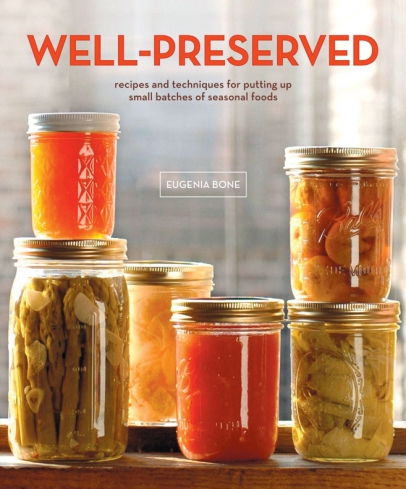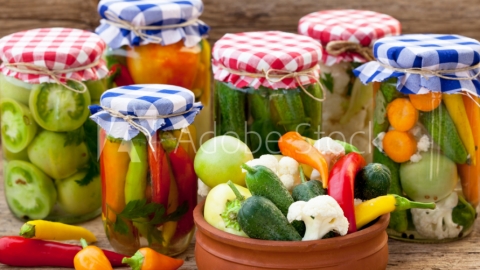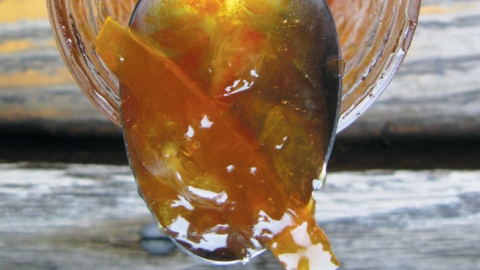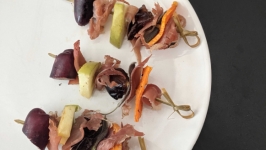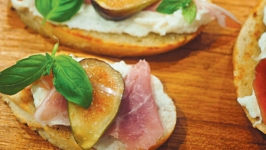Preserving for City Folks
I always walk to my local farmers’ market on Saturdays reciting the mantra I will not over-buy, I will not over-buy. Then I smell the strawberries, or notice the yellow zucchini blossoms, the tomatoes fragrant as flowers and the sea scallops cold and fresh off The Brianna, the sweet corn a dozen ears for $3, and nettles? I love them!
When my husband sees all that food he inevitably gives me the “You need to join a group” look. But within a couple of days, I manage to process all that glorious produce into jars and freezer bags, tucked away for future use, preserving the season in all its wonderful optimism and freshness. So I can because I can’t resist buying, but I also can because I can’t give up the day. I just want the bounty to go on forever, and in ways both literal and metaphorical, canning is a tactic for capturing time—and saving it.
During the course of the year I put up a wide variety of foods that I use in multiple dishes, from cured bacon—which is ridiculously easy and quantitatively better than commercial— to make frisee salad with lardons and poached eggs and savory chicken Canzanese with bacon, garlic, sage and rosemary; to Foriana sauce packed in oil and refrigerated, a combination of walnuts, pine nuts, raisins, garlic and oregano, which I use to stuff clams and thick-cut pork chops. I preserve all sorts of things: smoked chicken breasts for salads and sandwiches; pickled cauliflower to make a delicate poached fish salad, and a romping vegetable side with tomatoes and black olives; and brandied figs, to cook into sweet rich sauces for quail and duck, stir into mashed sweet potatoes or make into a grownup Fig Newton.
In the fall I can tuna and, after allowing it to season for six months, I use it in pasta dishes, composed salads or vitello tonnato, all excellent in the spring. I also make sweet concoctions, like frozen grated apples flavored with warm pie spices, which I defrost and dump in a sweet crust to make a pie, or roll into a crisp strudel, and from the leftover juices, icy apple-pie-flavored granita; and Concord grape and walnut conserve, which I dump into a sweet crust to make a tart, or mix with chocolate, stuff into ravioli and fry.
About 25 percent of all households in the United States preserve foods, the majority of whom live in the country, and for all sorts of reasons: necessity, pleasure, health. (To wit: A serious canner friend of mine from Routt County, Colorado, told me a story about a mortician in her town. “He said in the past morticians used to have to get a body into the earth real quick, but nowadays a human body will hold for two weeks due to all the commercial preservatives he’s eaten.”) Home canning reduces your carbon footprint, increases the quality of your dining experience and provides a sense of independence from the industrial food complex—all excellent reasons to get into it.
Small batch recipes can be done in a tiny kitchen, and if the recipes are sophisticated but simple, and constitute the primary flavor of dishes that can be prepared over the next few weeks or months, up to a year, you can save lots of time on shopping and dinner preparation. Plus, it’s rewarding, relaxing and cheaper than psychotherapy. And of course, canning is a very satisfying approach to eating during a recession.
It’s a total kick to be able to throw a dinner party where all you have to do is buy the protein and the garnish. I threw a winter dinner for six where I served pickled asparagus with boiled eggs, spaghetti with Foriana (nut, cheese and raisin) sauce, duck with brandied figs and cherries in wine with whipped cream. Here’s my grocery list:
Eggs
1 pound spaghetti
Grated Parmesan cheese
2 duck breasts
1 bunch fresh thyme
2 shallots
1 pint heavy cream
The only things I didn’t have in my kitchen were the duck and the thyme. I didn’t even have to pay attention to the dinner until about an hour before my guests were due to show up. Here’s another, a spring dinner: ricotta pie with marinated artichokes, swordfish with fava cream, crepes with three-citrus marmalade. Again, I only had to buy the ricotta, swordfish and fresh mint. (OK—I had to make the crust, but I did it in the morning before work.) My point is, despite the fact that canning is primarily a country occupation; it makes a hellavalot of sense in the city, too.
An excerpt from Well-Preserved: Recipes and techniques for putting up small batches of seasonal foods (Clarkson Potter, May 2009).


